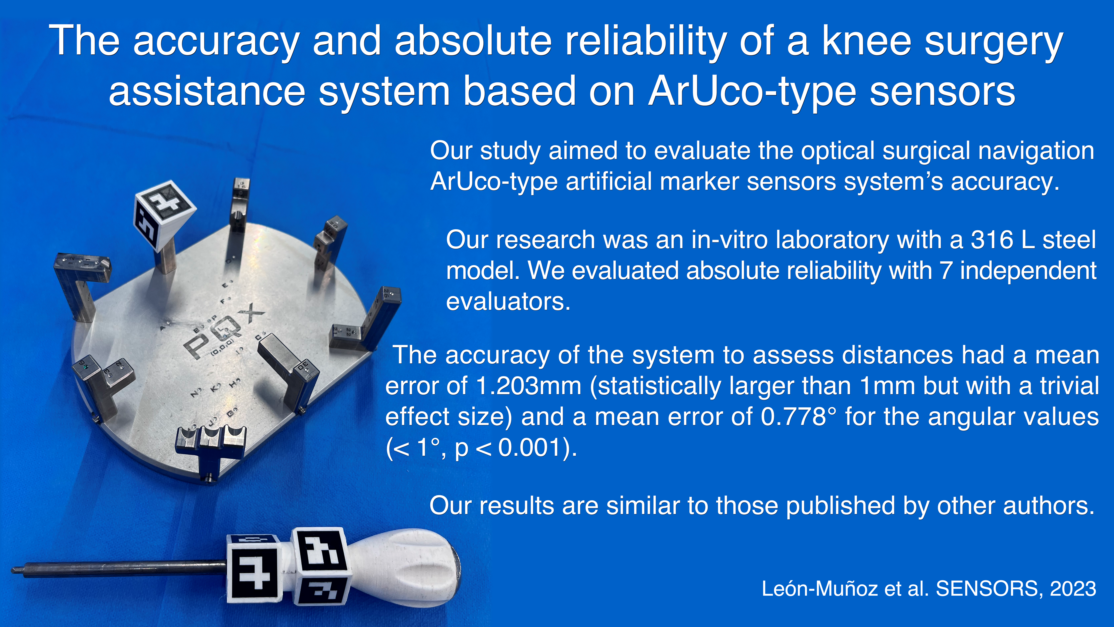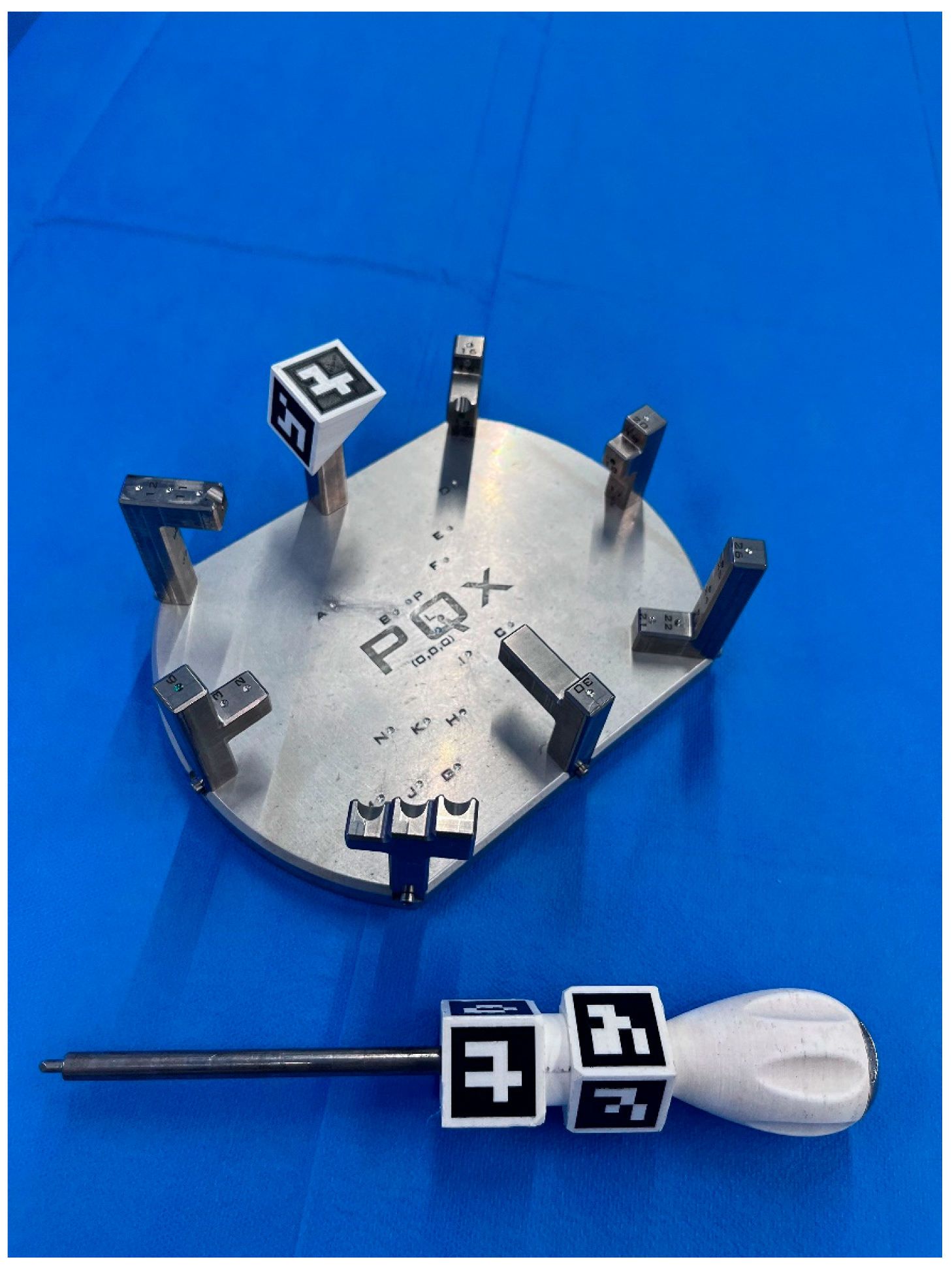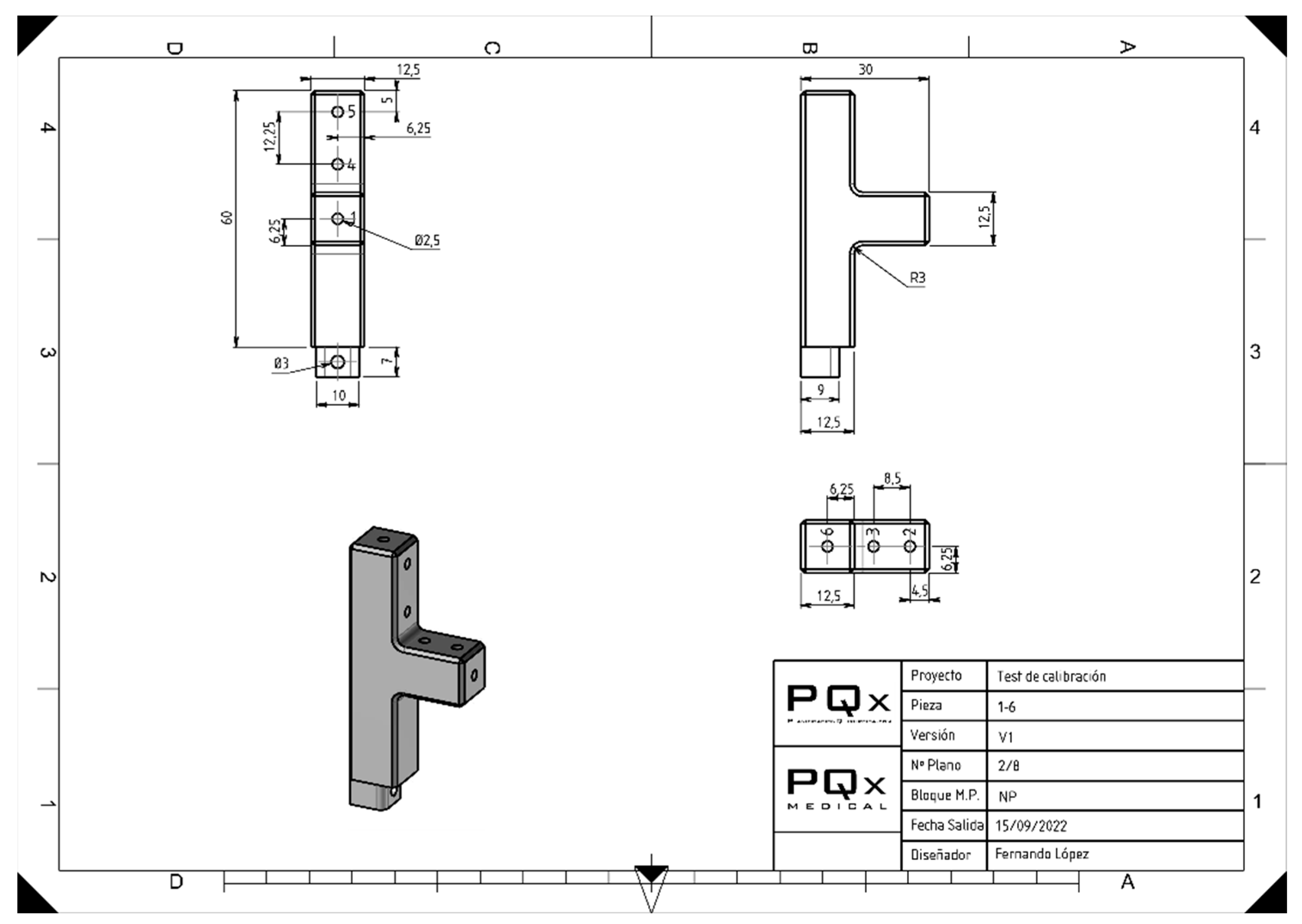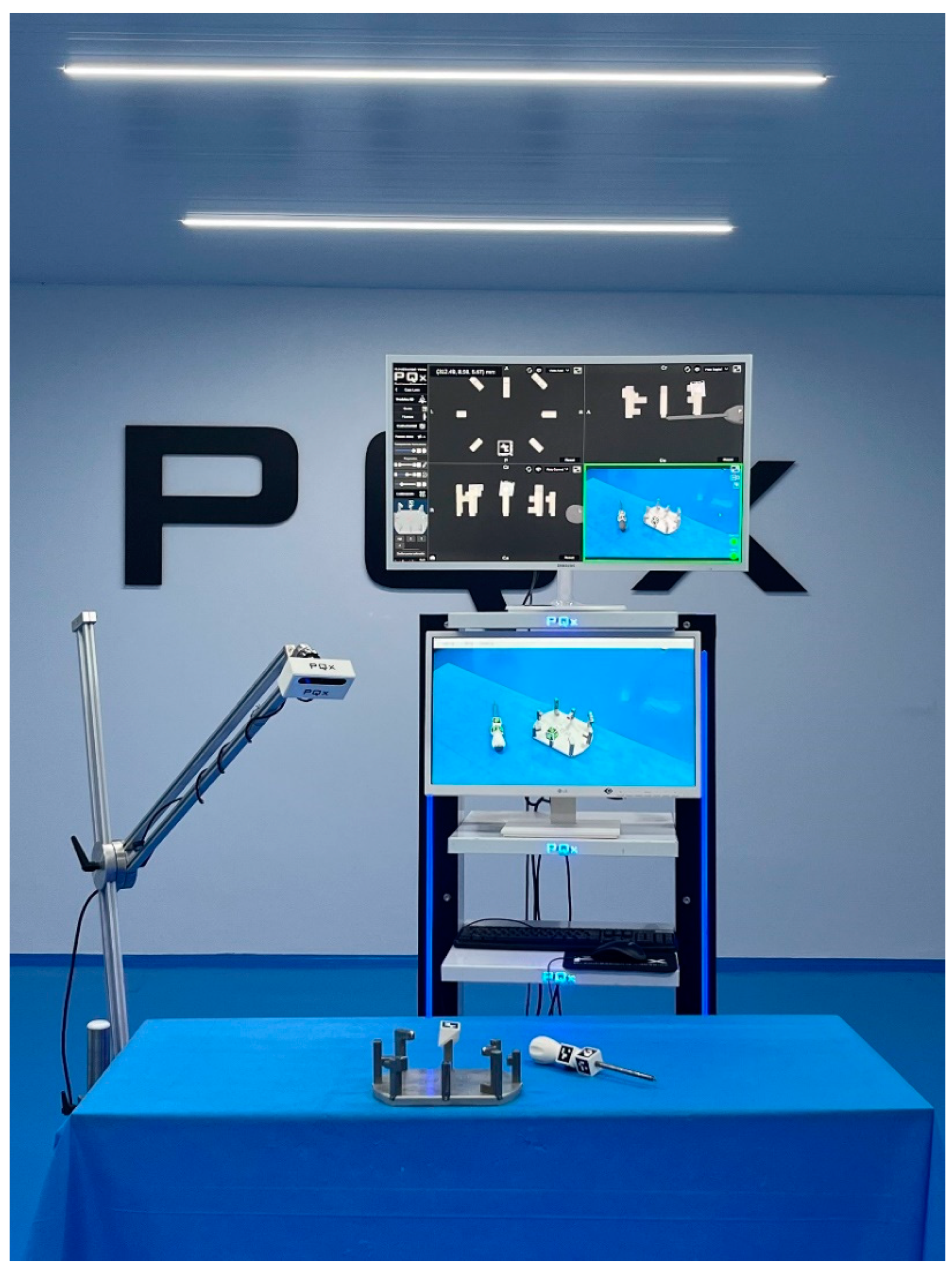1. Introduction
Using manual measuring instruments such as graduated rulers, callipers, and goniometers to determine distances and angular values is frequent in knee surgery. Any measuring device to be valid must be precise, accurate, and show adequate resolution and sensitivity. To be more accurate in our surgeries, we have progressively introduced highly accurate spatial measurement systems in operating rooms (OR). Since the late 1990s, computer-assisted surgery (CAS) has been introduced as an aid for knee surgery, mainly in prosthetic surgery, with the primary objective of increasing geometric precision [
1,
2]. In addition, CAS can provide the surgeon with real-time and 3D information. CAS systems operate based on a virtual element of the natural anatomical one. This virtual element is extracted by prior digitalisation of studies by the image of the anatomical one or by intraoperative digitalisation, based on the acquisition of reference points that are processed to establish the geometry of this anatomical structure. The navigator consists of a computer platform, a tracking system, and a series of markers. The computing platform coordinates the flow of information, interprets it, and automatically performs the relevant mathematical and logical operations according to a given sequence of instructions. The tracking system is the communication mechanism between the markers on the anatomical element and the computer platform. Due to their reliability and accuracy, the most used tracking systems are optical trackers using infrared electromagnetic radiation (active or passive reflecting diodes). Several infrared detection cameras record the exact position of the emitters in an orthogonal coordinate system. With this type of system, a mean error of less than 1mm or 1° (p < 0.001) has been estimated [
2]. A limitation of the navigation systems is that they force surgeons to look away from the surgical field and verify the navigated surgical gestures on a flat-screen monitor [
3].
Another drawback of conventional CAS systems is that the representation of the surgical gesture will occur in a completely virtual world, demanding the surgeon’s spatial-visual and oculomotor coordination skills to translate this virtual world into the real physical world. In addition, what the surgeon sees on the monitor is a photorealistic simulation of the 3D model in a two-dimensional image. Most recent advances allow the use of Augmented Reality (AR) for many medical procedures. Milgram and Kishino described in 1994 the overlap between the physical and digital worlds and placed AR in this reality-virtuality continuum [
4]. AR assigns the interaction between virtual environments and the physical world, allowing both to intermingle (AR superimposes information on real objects in real-time) through a technological device (usually smart glasses). AR has the potential to circumvent the limitations of current navigation systems by improving anatomical visualisation, surgeon ergonomics and intraoperative workflow [
3,
5]. We have developed some experience in different AR-assisted knee surgery techniques using optical surgical navigation with ArUco-type artificial marker sensors [
6,
7,
8]. ArUco is a minimal library for AR applications based exclusively on OpenCV (Open Source Computer Vision Library) that relies on black-and-white (b/w) markers with codes detected by calling a single function [
6].
Our study aimed to evaluate the accuracy of measurements made with ArUco marker pointers detected by optical cameras using an in vitro protocol, adding errors attributable to the observer. We hypothesised that the system’s accuracy was like conventional CAS systems and, therefore, equal to or less than 1mm and 1° for distance and angular measurements, respectively.
2. Materials and Methods
Our research consists of an in-vitro laboratory study to determine the accuracy of a navigation system based on detecting non-natural markers by optical cameras. We have decided to conduct an in vitro study because of the advantages of tight control of the physical environment, reduced cost, reduction of statistical errors and higher throughput. Due to its characteristics, the study does not require ethical approval.
Together with the bioengineers at PQx Planificación Quirúrgica (PQx Planificación Quirúrgica, Murcia, Spain), a MedTech Start-Up with which we plan some of our interventions, we developed a model that would allow us to accurately locate several points (simulating the palpation of bony landmarks during knee surgery). We manufacture the model from 316 L steel, according to AISI (American Iron and Steel Institute) standards (Cr (16.5/18.5%) Ni (10.5/13.5%) Mo (2/2.25%) C (< 0.03%)). It is an austenitic stainless steel, which is neither magnetic nor hardenable. It stands out from other steels due to the presence of 2-2.5% molybdenum, which provides it with a high corrosion resistance. We manufacture the feeler stylus from 17-4PH—steel (AISI 630) ((Cr (15/17%) Ni (3/5%) Cu (3/5%) Nb 5xC/0.45% C (<0.07%)). AISI 630 is a martensitic hardenable, stainless steel with high wear resistance, good corrosion resistance and high yield strength.
We designed the model with TopSolid’Design software (TopSolid, Missler Software, France). TopSolid is an integrated CAD/CAM software for designing and creating fully functional 3D parts. As shown in
Figure 1,
Figure 2 and
Figure 3, we designed a platform and towers on it with thirty palpation points to simulate bony landmarks and with various trademarks to acquire direct angular measurements. Before each acquisition, the observer calibrated the system by palpating the (x, y, z) point of the model and three reference points. The distances and angles determined were relative to this (x, y, z) point.
Fiducial markers are artificial landmarks added to a scene that help find point correspondences between images or between images and known models [
9]. We employed ArUco-type artificial marker sensors for optical surgical navigation, a simple library for augmented reality applications that only use OpenCV and depend on b/w markers with codes that can be detected by calling a single function [
8,
9]. OpenCV is a natively built C++ software library for computer vision and machine learning. It is an Apache 2 licensed product. OpenCV was developed to facilitate artificial perception and provide a common architecture for computer vision applications.
To create the marker detection software, we used Python 3.8.3 (Python Software Foundation, Wilmington, United States), and OpenCV 4.0.1 served as the computer vision library. For the graphics engine, we utilised Unity 2019.2.17f1 (Unity Software Inc., San Francisco, United States). The method used to calculate distances is the one proposed by Vector3.Distance: The system receives two points, a and b, in three dimensions and performs the magnitude operation (a–b), the magnitude operation being
[
8]. We used the angular calculation method proposed by Vector3.Angle: The system receives two three-dimensional vectors representing the two directions whose degree difference is to be found. These vectors are normalized, and then the scalar product is performed; the result is restricted between -1 and 1, its arccosine is obtained, and it is multiplied by 57.29578 (180/pi) to transform radians into degrees, returning the result in this magnitude [
8].
We produced the ArUco markers using an Ultimaker S3 printer (3D printing system) with double extrusion and a 230 × 190 × 200mm print volume (Ultimaker BV, Utrecht, The Netherlands). We employed polylactic acid (PLA) filament from Ultimaker (Ultimaker BV, Geldermalsen, The Netherlands) for the print [
8].
We employed an OAK-D camera (A00110-INTL) from Luxonis Holding Corporation in Denver, (USA), for our study. With a Display Field Of View (dFoV) of 81 degrees and a resolution of 12MP (4032 × 3040), the OAK-D baseboard features three integrated cameras that implement stereo and RGB vision. These cameras are connected directly to the OAK system in modules for depth processing and artificial intelligence.
The detection of ArUco markers, like other types of fiducial markers, is affected by noise, blur and occlusion, despite relative immunity to light variations [
9,
10]. To avoid bias, we maintained stable conditions for the camera, monitor and model position throughout the investigation, with a blue background using surgical drapes and observers wearing blue surgical gowns of the same blue colour. OR lamps generate an illuminance over the surgical field of between 10000 and 100000 lux, which is excessive for our optical cameras. In the OR, it is also recommended to set a minimum of 2000 lux around the surgical table and 1000 lux in the whole room. We maintained a stable illuminance of 300 lux for our test in an 80m
2 experimental room equipped with light-emitting diode (LED) technology.
We evaluated absolute reliability according to the Hopkins criteria (minimum n of 30, at least six blinded assessors, at least three tests per observer, separated by at least two weeks) [
11,
12]. We carried out the study with seven independent evaluators with different experience levels. We note the following variables as variables specific to each observer: age, dominance, years of orthopaedic surgery practice, experience in navigation systems in orthopaedic surgery, experience in arthroscopic surgery, regular gaming with video consoles or leisure use of virtual or augmented reality systems. According to research by several authors, regular use of gaming devices or involvement in sports demanding substantial hand-eye coordination has a good effect on how well surgical skills like arthroscopic methods are learned [
13,
14]. This is why we asked the observers about usual play with two-dimensional (2D) and three-dimensional (3D) devices. Each observer measured the thirty palpation points and the twelve trademarks to acquire direct angular measurements on three occasions separated by at least two weeks. In each measurement session, each observer made three acquisitions.
We performed the Statistical analysis using the Statistical Package for the Social Sciences (SPSS), version 25 for Windows (SPSS, Inc., Chicago, IL, USA). We used the average of the 1890 items for distance measurements and 756 items for angular values (each of the seven observers made 90 distance and 36 angle measurements in each of the three sessions separated by at least one week [270 length and 108 angle measurements per observer]) to evaluate the system’s validity. We used the Shapiro-Wilk test to check that the p values of the data were above the significance level of 0.05, with the null hypothesis that the data fit a normal distribution being accepted. All distributions met the normality criterion of this test. We use as reference values the distances between the (x, y, z) point, the different palpation points, and the different angular values defined in the design of the model using the CAD/CAM software. We used an arithmetic methodology that Lustig et al. [
2] employed to establish comparisons between the accuracy of conventional CAS systems and non-natural fiducial mark detection systems. For each distance between the (x, y, z) point and the 30 points of the in vitro model, we calculated the difference between the authentic distance (D) and the distance sensed by the observer (D’). We considered this difference to be the error x during the acquisition of distances with the optical navigation system. The criteria used to define the method’s accuracy were the mean error x (in mm) and the corresponding uncertainty U = 2×σ (σ being the standard deviation). The 95% confidence interval of the mean error was defined as (x−U; x+U). For each angular value, we calculated the difference between the real angular value (A) and the value sensed by the observer (A’). We considered this difference to be the error x during the acquisition of angles with the optical navigation system. The criteria used to define the method’s accuracy were the mean error x (in degrees) and the corresponding uncertainty U = 2×σ (σ being the standard deviation). The 95% confidence interval of the mean error was defined as (x−U; x+U). We also calculated the validity or degree of agreement between the mean value obtained from a large set of measurements and the actual value (MBE, mean bias error), the reliability (SD), the Standard Error of the Sample (SEM), and the intraclass correlation coefficient of absolute concordance using a two-factor random effects model [ICC (2,1)] [
15]. We assessed intra- and inter-observer reliability according to the criteria by Landis and Koch (<0 indicates no agreement, 0.00 to 0.20 indicates slight agreement, 0.21 to 0.40 indicates fair agreement, 0.41 to 0.60 indicates moderate agreement, 0.61 to 0.80 indicates substantial agreement, and 0.81 to 1.0 indicates almost perfect or perfect agreement) [
16]. We calculated as well RMSE (Root Mean Square Error or Root Mean Square Deviation), MAE (Mean Absolute Error), and Mean Squared Error (MSE). In addition, we quantified the effect size using Cohen’s d-value (the difference between means) and with the correlation coefficient (r), i.e., the magnitude of the association. d-value to quantify the magnitude of an effect (the difference between means) can be interpreted according to the criteria by Hopkins et al. [
17]: less than 0.2, trivial; 0.2 to 0.59, small; 0.6 to 1.19, moderate; 1.20 to 2, large; 2.1 to 3.99, very large, and greater than 4, extremely large. For the correlation coefficient, Cohen considers that a large effect corresponds to r = 0.5, medium to r = 0.3, and small to r = 0.1 [
18].
4. Discussion
The main aim of our study was to determine the inaccuracy that occurs in the acquisition of points in space using an ArUco marker system detected by optical cameras in an in vitro protocol. Contrary to other studies [
2], the system’s accuracy was analysed, and the effect of the surgeon was included, with seven observers with different levels of experience. According to our results, the distances evaluated showed a mean error of more than 1mm (1.203mm; p < 0.001), which is a trivial effect size using Cohen’s d value (0.003), and the angle determination had a mean error of less than 1° (0.778°; p < 0.001). In addition, intra- and inter-observer variability has been minimal. To the best of our knowledge, no studies assess the accuracy of this type of fiducial markers that meet absolute reliability criteria [
17].
Can we accept a 6mm or 4° error in knee surgery? No, obviously not. Our hypothesis to explain these maximum errors is that they are due to the operators. If there is a movement of the sensors just at the time of the measurement acquisition, the measurement will be in error. The significant negative Pearson correlation between the errors in determining the distances and the time spent in the recording would support this hypothesis. Therefore, to evaluate the actual accuracy of the system, it would be essential to experiment with conditions of absolute independence of human error, as has been done with other systems [
2].
Technological innovation in surgical workflows is necessary, but in innovating, we are always at risk of a certain technological arrogance if we do not contribute to augmented humanity, as defined by Guerrero et al. [
19]: “Augmented humanity is a human–computer integration technology that proposes to improve capacity and productivity by changing or increasing the normal ranges of human function, through the restoration or extension of human physical, intellectual and social capabilities”. The discussion often focuses on balancing the clinical benefit of technological innovation with the added time and cost usually associated with it. One avoidance of such technological arrogance is to increase accuracy (or at least precision) relative to the pre-innovation standard.
Several authors have published trials evaluating the accuracy of extended reality (XR) systems concerning hip [
20,
21,
22,
23,
24] and knee surgery [
25,
26,
27,
28,
29,
30,
31].
Fallavollita et al. [
25] evaluated whether an AR technology can provide accurate, efficient, and reliable intraoperative alignment control of the mechanical axis deviation (distance from the knee joint centre to the line connecting the hip and ankle joint centres). A camera-augmented mobile C-arm (CamC) was used as AR technology, and five participants with different surgical experience levels determined the anatomical landmarks defining the mechanical axis and centre of the knee in twenty-five human cadaveric specimens. The authors demonstrated that the AR technology provides accurate mechanical axis deviation (no significant difference between CamC and CT values and a strong positive correlation, which means that CamC values go with the CT values) [
25].
Tsukada et al. [
26] performed a pilot study to examine the accuracy of an imageless navigation system using AR technology with resin markers with a square 2-dimensional bar code (the system allows the surgeon to view the tibial axis superimposed on the surgical field through the display of a smartphone, similar to Ogawa et al. [
23]) for total knee arthroplasty (TKA). Using the system, one surgeon resected ten pairs of tibial sawbones by viewing the tibial axis and aiming varus/valgus, posterior slope, internal/external rotation angles, and resection level superimposed on the surgical field. No significant differences existed between the angles displayed on the smartphone screen, and the measurement angles determined using CT. The system indicated varus/valgus and posterior slope angles of less than 1° and internal/external rotation angles of less than 2° for the differences between the values displayed on the smartphone screen and the actual measurement values. Although the mean difference of 0.6mm ± 0.7mm in terms of the thickness of resected bone was also comparable to that of the conventional navigation systems, the authors [
26] believe that the value of the mean difference can represent an unacceptable error for correct balancing during TKA.
Tsukada et al. [
27] performed a two-phase study to evaluate the accuracy of the AR system in distal femoral resection during TKA. First, a total of ten femoral sawbones specimens were resected by a single surgeon. The absolute values of the differences between the angles measured using CT and the angles displayed on the smartphone screen were 0.8° ± 0.5° (range, 0.3° to 1.9°) in the coronal plane and 0.6° ± 0.5° (range, 0.0° to 1.4°) in the sagittal plane. Secondly, the authors performed a clinical study on 72 TKA (distal femoral resection with the AR system vs with conventional intramedullary guide, with the target of femoral coronal alignment perpendicular to the mechanical axis in both groups). In the clinical study (evaluating postoperative standing long-leg radiographs), the mean absolute value of the error in coronal alignment was significantly smaller in the AR-based navigation group than in the intramedullary guide group (1.1° ± 1.0° [range, 0.0° to 3.2°] compared with 2.2° ± 1.6° [range, 0.0° to 5.5°], respectively; 95% confidence interval, 0.5° to 1.8°; p < 0.001).
Recently, Tsukada et al. [
28] evaluated the accuracy of the AR system (adapting Quick Response [QR] coded markers to the extramedullary cutting guide and pointer and with the system described in their previous publications [
26,
27], using a smartphone camera as a sensor) in tibial osteotomy of unicompartmental knee prostheses. The authors [
28] published absolute differences between the preoperative target resection angles and postoperative measured angles of 1.9° ± 1.5° in the coronal alignment and 2.6° ± 1.2° in the sagittal alignment.
Iacono et al. [
29] prospectively studied the alignment accuracy of the Knee+ AR navigation system in five consecutive patients (Pixee Medical Company, Besançon, France). The Knee+ system consists of smart glasses worn by the surgeon, a laptop, and specific QR-coded markers connected with tibial and femur resection guides. It allows the surgeon to view the tibial and femur axis superimposed on the surgical field through smart glasses. The authors [
29] published a cutting error of less than 1° of difference in the femur and tibia coronal alignment and less than 2° about flexion/extension of the femur and posterior tibial slope. Bennett et al. [
30] recently published a prospective, consecutive series of twenty patients undergoing TKA utilising the Knee+ system and determining the coronal and sagittal alignment of the femoral and tibial bone cuts measured on postoperative CT scans. The employed system produced a mean absolute error of 1.4°, 2.0°, 1.1° and 1.6° for the femoral coronal, femoral sagittal, tibial coronal and tibial sagittal alignments, respectively. The authors [
30] concluded that AR navigation could achieve accurate alignment of TKA with a low rate of component malposition in the coronal plane but with more significant inaccuracy in the sagittal plane, which conditions some sagittal outliers.
Pokhrel et al. [
31] propose a system based on a volume subtraction technique that considers the history of the area which has been cut and measures it for the target shape. The authors postulate that using fiducial markers and bulky trackers presents significant limitations in terms of errors and barriers to surgical setup. They propose adapting the 3D-2D shape-matching integration and stereoscopic tracking proposed by Wang et al. [
32,
33] into the Tracking Learning Detection algorithm for real-time registration with the Iterative Closest Point as the medium for overlay model refinement. Image registration tracks the patient and matches 3D contours in real-time without fiducial markers or references. The real-time autostereoscopic 3D images are implemented with the help of a Graphics Processing Unit. The remaining area to be cut is calculated with the volumetric analysis of the area already cut and the total area to be cut. With the proposed algorithm, the authors publish an increase in video accuracy to 0.40 to 0.55mm overlay error [
31].
Our results (mean error of 1.203mm for the distances and 0.778° for the angles evaluation) are similar to those published by other authors in accuracy analyses of AR systems [
27,
28,
29,
30] and values that do not differ significantly from those published for CAS-, PSI- or robotic-assisted knee surgery. The evaluated system may be suitable for knee surgeries, not limited to TKA surgery.
There are some limitations to our study. First, contrary to another study [
2], we have not tested the technology’s accuracy in isolation by designing a system independent of the observer. Technology is not user-independent, so we decided to incorporate the possible effect of observer-induced error methodologically. Second, we have designed similar conditions to the acquisition of anatomical knee landmarks (distances from 47.49mm to 117.77mm and angles from 35° to 81.04°), access difficulty levels for both right-handed and left-handed observers and boundary positions so that optical cameras captured the ArUco markers in conditions that were far from optimal and as “real” as possible, however, this is still an in vitro model that differs from the anatomy of a knee and from the texture of the knee tissues which are very different from 316 L Steel (as it is a model with well-defined indentations, we have avoided the bias due to observer variability in the determination of the anatomical landmarks). Keeping the conditions of the experimental room environment constant is also a strength, but it distances the research from the “real” conditions in the operating theatre. For example, we have determined the illuminance in our experimental room with an average value of 300 lux in 10 measurements at different points, which is lower than the usual illumination in an OR. This is a limitation under actual conditions but a strength in demonstrating that the optical detection of ArUco-type markers is accurate at low light. Third, we could have used smart glasses, but we decided that the entire trial would be conducted with direct vision of a monitor. We have yet to assess whether there is a difference in accuracy with the use of smart glasses, a study that may be of some interest.
Author Contributions
Conceptualization, Vicente León-Muñoz, Fernando Santonja-Medina, Francisco Lajara-Marco and Joaquín Moya-Angeler; Data curation, Mirian López-López; Formal analysis, Vicente León-Muñoz and Mirian López-López; Investigation, Vicente León-Muñoz, Fernando Santonja-Medina, Francisco Lajara-Marco, Alonso Lisón-Almagro, Jesús Jiménez-Olivares, Carmelo Marín-Martínez, Salvador Amor-Jiménez, Elena Galián-Muñoz and Joaquín Moya-Angeler; Methodology, Vicente León-Muñoz, Fernando Santonja-Medina, Francisco Lajara-Marco and Joaquín Moya-Angeler; Project administration, Vicente León-Muñoz; Supervision, Vicente León-Muñoz, Fernando Santonja-Medina and Joaquín Moya-Angeler; Validation, Vicente León-Muñoz; Visualization, Vicente León-Muñoz; Writing—original draft, Vicente León-Muñoz; Writing—review & editing, Vicente León-Muñoz.









